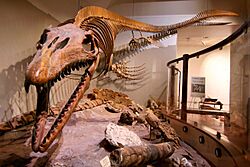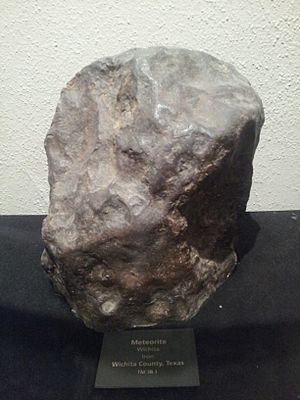Texas Science and Natural History Museum facts for kids

Onion Creek Mosasaur skeleton
|
|
| Established | 1939 |
|---|---|
| Location | 2400 Trinity Street Austin, Texas |
| Type | Natural history museum |
| Owner | The University of Texas at Austin |
The Texas Science & Natural History Museum is a super cool place to explore science and nature! It's located right on the campus of The University of Texas at Austin in Austin, Texas, USA.
This museum first opened its doors on January 15, 1939. Back then, it was called the Texas Memorial Museum. It was built as part of the preparations for the Texas Centennial Exposition, a big celebration held in 1936. Even President Franklin D. Roosevelt helped start the building's construction in 1936! The building itself is a neat example of Art Deco style, which was popular at the time.
The museum focuses on natural history. This means you can learn all about:
- Paleontology: The study of ancient life, like dinosaurs and fossils!
- Geology: How Earth is made, including rocks, minerals, and landforms.
- Biology: The study of all living things, from tiny cells to huge animals.
- Herpetology: Reptiles and amphibians, like snakes, lizards, and frogs.
- Ichthyology: All about fish!
- Entomology: The fascinating world of insects.
The museum has won "Best of Austin" awards from the Austin Chronicle several times, showing how much people love it!
In 2001, some of the museum's exhibits about Texas history and different cultures were moved to other museums, like the Bullock Texas State History Museum.
The museum closed for a while in 2022 to get a big makeover. It was updated and given its new name, the Texas Science & Natural History Museum. It reopened on September 23, 2023, ready for new visitors to explore!
Discover the Wichita County Meteorite
One of the most amazing things you can see at the museum is the Wichita County Meteorite. This isn't just any rock; it's a piece of space that fell to Earth!
Long ago, in 1723, the Comanche people won a big battle against the Lipan Apache people near a river they called the Rio del Fierro, or "River of Iron." This river might be where a French explorer, Athanase De Mezieres, wrote about in 1772. He described "a mass of metal which the Indians say is hard, thick, heavy, and composed of iron." The Native Americans thought it was very special and called it "standing rock" or "medicine rock." They believed it had special powers.
"According to the Indians, the mass was first discovered by the Spaniards, who made several ineffectual attempts to remove it on pack mules but were finally compelled to abandon it on account of its great weight. The Comanches at first endeavored to melt the mass by building large fires around it, but failing in this, they next attempted to break it in pieces, in which they were likewise unsuccessful; they then conceived the idea that it was a wonderful medicine stone and therefore worthy of their most profound regard...it was the custom of all who passed by to deposit upon it beads, arrowheads, tobacco, and other articles as offerings."
The Wichita County meteorite originally weighed about 145 kilograms (that's over 300 pounds!). A US Indian agent named Major Robert Neighbors got the meteorite in 1858 or 1859. He gave it to the State Cabinet, and it was displayed in the old Capitol building. After the Capitol building burned down, this special space rock was given to the University of Texas, where it found its home in the museum.
Major Neighbors said that when the meteorite was moved, the Comanches gathered around it. They showed how much they loved their "medicine stone" by rubbing their arms, hands, and chests on it. They really wanted Major Neighbors to let them keep it!
There's also a "sister" meteorite, called the Red River meteorite, which is much bigger, weighing 742 kilograms. It was found in 1808 and is now at the Yale Peabody Museum of Natural History.


